Editorial: Whatever One Sows

In April, May and June of 2006 (PT 21, 22, 23) The Peaceable Table featured a three-part editorial entitled "The Animals and the Angels," dealing with the question of life after death for both human and nonhuman animals. The first section reflected upon William Blake's poem "Night," which describes compassionate angels blessing sleeping animals and escorting to paradise the souls of those killed by predators. The second part went on to present evidence, from deathbed visions and Near-Death Experiences (NDEs), of human survival of death. Dying humans sometimes report apparitions of loved ones or other caring beings coming to escort them into the beyond. This would not in itself be evidential, but bystanders at deathbeds occasionally perceive these figures as well, and some bystanders, in the process, gain information they could not have known by normal means. The third section cited cases of apparitions or other manifestations of deceased animals; in one instance the apparition of a dog appeared not to his grieving guardian but to a chiropractor who had helped ease the dog's pain. The chiropractor, having been convinced that life beyond death was impossible, was traumatized by the unwelcome vision. Reports like this, probably the tip of the iceberg, do not qualify as proof but deserve to be regarded seriously. Some of these accounts strongly indicate that human consciousness, far from becoming extinct at death, expands exponentially. Indications are that companion animals--perhaps all animals with a definite individuality--probably survive on some level as well.
The Life Review
The present essay can be seen as continuous with the earlier series. It does not focus on animal survival but on what some of the (human) near-death phenomena imply for our relationship with animals here and now. I have in mind a highly developed form of what is usually called the Life Review. Almost everyone has heard of the idea (derived from the writings of Thomas de Quincey) that "a drowning person sees his whole life flash before his eyes." In fact the phenomenon of seeing such images of one's life is not limited to victims of near-drowning. For example, nineteenth-century Swiss geologist Albert Heim, while on a mountain-climbing expedition, lost his footing and plunged more than sixty feet. During the ten seconds or so that he was falling, his mind, quite serene and without fear, produced a torrent of clear and coherent thought, which he afterwards remembered in detail. Besides planning actions he would take if he survived, he saw, "as though on a stage," his "whole past life . . . in many images," united in "elevated and harmonious thoughts," despite some very painful experiences he had had.
Similarly, a soldier injured in the Vietnam war by six rounds of machine-gun fire tells how he entered a peaceful state in which "my life began to become a picture in front of me, [beginning with] the time when I was still a baby, and the pictures seemed to progress through my whole life. I could remember everything; everything was so vivid . . ." Like Heim, he found the review to be a completely positive thing; he had "no regrets."
For other experiencers, however, there were definite regrets. The encounter with their past took place in a heightened state of spiritual sensitivity in which they felt surrounded by a loving Light or Presence, and realized that love is the standard for all thoughts, words, and actions. Stripped of rationalizations and self-flattering excuses for certain things they had said and done, they recognized the extent of their harmfulness. One said, "After I could see the mean little things I did as a child, . . . I wished I could go back and undo them." Another said "I was really very, very ashamed of a lot of the things that I experienced . . . . The light was showing me what I did wrong . . ."
Empathy
A limited number of those who returned from the brink of death had a still deeper level of encounter with their own pasts. Not only did they perceive everything they had done, and realize that a good deal of it had been harmful; they seemed to be living it all over again, not only from their own perspective, but with a consciousness expanded to include empathy with everyone else upon whom they had had an impact. P.M.H."Phyllis" Atwater says of her life review in 1977:
For me, it was a total reliving of every thought . . ., every word . . . , and every deed . . .; plus the effect of each thought, word, and deed on everyone . . . who had ever come within my . . . sphere of influence . . . (including unknown passersby in the street); plus the effect . . . on weather, plants, animals, soil . . . No slip of the tongue or slur was missed . . . If there is such a thing as hell, as far as I am concerned this was hell . . . The old saying "No man is an island," took on graphic proportions.
Perhaps the most vivid description of an empathic life review is that of Tom Sawyer (his real name), late of Rochester, N.Y., whose NDE took place in 1978 when a car he was repairing fell on him and began to suffocate him. Out of his all-encompassing reliving of his prior life, he describes a few scenes in detail. For example, once during his teen years when he was stopped at a traffic light, a pedestrian almost walked right into his cherished pickup truck. Through his opened window Tom insulted this man, who responded by slapping his face. Feeling justified, Tom stepped out and punched him, not once or twice but thirty-two times. During his life review, Tom not only relived his own feelings of indignation at the imagined affront to his pickup, he also in effect became the other, looked at Tom Sawyer's flushed face out of the man's eyes, and felt the pain and humiliation of every one of those blows. More, Tom knew the man's age, knew the house where he lived, and knew he was drunk because he was in grief at the death of his wife. He knew the barstool where the man had sat drinking, and the path he had taken to that street corner. He knew the man's home; he experienced intimate personal details of his life.
Tom also felt the effects of good things he had done, some seemingly trivial; for example, in his childhood he had once expressed love for a beautiful tree, and he now felt the tree's responding well-being. This empathy applies also to animals, he reports, even to insects. All things affect all other things.
One would expect that, reflecting on the implications of this powerful experience, Tom would have become a vegetarian. He did change enormously in many ways--including ceasing to be a wife-batterer and instead becoming a counselor to wife-batterers--but at the time I met and spoke with him in the 1990s, Tom had regrettably not stopped eating animals.
The empathic life review of Betty Eadie involved not only feeling the impact she had had on others, but also the effects these others had on still others. "I was shown the "ripple effect" . . . I saw how I had often wronged people and how they had often turned to others and committed a similar wrong. This chain continued from victim to victim, like a circle of dominoes . . . . My pain multiplied and became unbearable." But this dreadful circle was not the last word; her life review took place in the presence of a loving Christ, who had compassion on her in her severe self-judgment. Furthermore, she found that the ripple effect also worked in situations of goodwill and kindness, spreading further goodwill and kindness.
Dannion Brinkley is one of the few NDErs I know of who mentions specific scenes in his empathic life reviews in which he felt the effects of his actions on animals. In Saved by the Light he tells of an episode in which he went into a rage at his dog for soiling the rug, and beat him. In the re-living, he not only experienced again his own anger, but also the dog's pain, fear and confusion at the violent assault.
It must be acknowledged that Brinkley is a controversial figure. While there is little doubt that he had powerful and life-changing NDEs, it is also true that he is a self-dramatizing personality who may have embroidered some of the spiritual adventures he describes. Thus, although I reserve judgment about certain elements in his account, incidents like the one with the dog are (unhappily) commonplace, only too true to life.
Reflections
Although the Near-Death Experiencers who have undergone empathic life reviews do not seem to be many, there are some thinkers and spiritual teachers who assert that all of us can expect to undergo such an encounter at some point after death. It has been suggested that the biblical image of the Great Judgment is a symbol of this encounter with the self. If this is the case, the idea is not so obscure after all. Not only traditional Christianity and Islam, but folk Buddhism and concepts about the afterlife in ancient Egypt present varying versions of a Judgment. Their main difference from the empathic life review is that in the latter, the judgment is not made by an impersonal power or an authority figure, but by oneself.
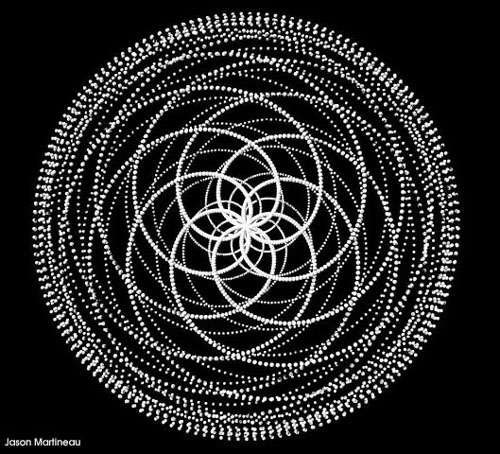 In his book Whole in One, British philosopher David Lorimer relates the empathic life review to better-known psychic phenomena such as telepathy, and to many mystics' sense of participation in the life of all things. Lorimer sees such phenomena as evidence of a universal "empathic resonance," the basis of an "ethic of interconnectedness." In other words, if conscience tells us that callous or sadistic treatment of others is wrong, the reason is our intuition that at a deep level we participate in the pain we cause to other living beings--though in ordinary incarnate life we may not feel that pain. If "Love your neighbor as yourself" and "Love your enemy" are good advice, it is because we participate in the blessings and benefits we confer on our enemies and our neighbors, including our animal neighbors and the planet as a whole. There is no wall restricting moral principles to one's own group, or even to human beings. Eventually, we may expect to know it in a very concrete way.
In his book Whole in One, British philosopher David Lorimer relates the empathic life review to better-known psychic phenomena such as telepathy, and to many mystics' sense of participation in the life of all things. Lorimer sees such phenomena as evidence of a universal "empathic resonance," the basis of an "ethic of interconnectedness." In other words, if conscience tells us that callous or sadistic treatment of others is wrong, the reason is our intuition that at a deep level we participate in the pain we cause to other living beings--though in ordinary incarnate life we may not feel that pain. If "Love your neighbor as yourself" and "Love your enemy" are good advice, it is because we participate in the blessings and benefits we confer on our enemies and our neighbors, including our animal neighbors and the planet as a whole. There is no wall restricting moral principles to one's own group, or even to human beings. Eventually, we may expect to know it in a very concrete way.
—Gracia Fay Ellwood
Sources: Sidney Saylor Farr, What Tom Sawyer Learned From Dying; Betty Eadie, Embraced by the Light; P.M.H. Atwater, Coming Back to Life; Albert von St. Gallen Heim, "Notizen uber den Tod durch Absturz" (Remarks on Fatal Falls); Raymond Moody, Life After Life and Reflections on Life After Life; Gracia Fay Ellwood, The Uttermost Deep.
We invite responses to editorials or any other feature of PT for our next issue's letter column: graciafay@gmail.com.
News Notes
Fifth Interfaith Celebration of Animals
This annual event, sponsored by the World Congress of Faiths & Quaker Concern for Animals, was held at the Golders Green Unitarian church, London, on September 14 . The service was again led by the Rev. Feargus O’Connor, with the guest preacher being the Rev. Dr. Marcus Braybrooke.
Speakers offered readings from Buddhism, Hinduism, Jainism , Sikhism, Christianity, Judaism, Spiritualism, the Unitarians and Islam. The theme which linked all philosophies was compassion, respect for all forms of life and the connections we share with other beings.
The Jewish speaker mentioned that when the beloved cat of the rabbi Hadassah Davies died suddenly one Friday, they could not welcome Shabbat in the usual joyful way until they had said Kaddish (prayers for the dead) and lit candles for this cat. Hadassah has since written a Pet Bereavement Liturgy.
The Spiritualist speaker read the beautiful poem "The Revelation" by Elizabeth Doten, part of which appears in our "Poetry" section below.
The Muslim speaker outlined the Islamic perspective on how animals are communities like man; they glorify God in ways we do not know, but God knows what they do. He mentioned how Solomon (Suleiman) could speak to animals; conversations with bees, birds and ants are mentioned in the Qu’ran.
Quaker Concern for Animals contributed John Woolman’s statement, which ends with “To say we love God and at the same time exercise cruelty to the least creature, is a contradiction in itself," together with a Christina Rosetti poem that is also reproduced below.
--Contributed by Marian Hussenbux
Brave Teenagers
Early in September three Ellwoods attended a fund-raising gala at Animal Acres, the farmed-animal sanctuary near Acton, California. One of its high points was an award to two high schoolers named Ariel Clark and Andrew Gardner, students at different schools, and thus probably independent of one another. Each had been a former member of Future Farmers of America, and each had been raising a pig. When they learned that the expected destination of their porcine friends was the slaughterhouse, Andrew and Ariel had the compassionate courage to resist the adults around them and say No way! They cast about and found that they could give their pig friends a permanent home at Animal Acres, where the pigs are now enjoying the good life. The teenagers received a prolonged, standing ovation from the crowd.
Letters:
 Thank you so very much for sending me The Peaceable Table. I printed off all 18 pages since two of my favorite topics were mentioned: King Arthur and the Holy Grail, and St. Melangell.
Thank you so very much for sending me The Peaceable Table. I printed off all 18 pages since two of my favorite topics were mentioned: King Arthur and the Holy Grail, and St. Melangell.
I actually visited her
Church of St. Melangell, Pennant, Wales
shrine in North Wales a few years ago. It was a field trip for a course in Celtic Christianity I was taking. The 'conductor' for that trip was the former Archdeacon (Anglican) of that area. He said the foundation of the shrine had been crumbling and during the renovation it was discovered the shrine had been built over the remains of an ancient Druid worship site. By the lych gate there was an ancient yew tree which was sacred to the Druids. One could feel the holiness of the place; in fact, it was the holiest I had ever experienced.
I am a Benedictine monk in the Episcopal Church and a vegan. Two religious groups I have always felt a great affinity for are the Quakers and the Mennonites. Another is the Shakers.
I forwarded The Peaceable Table to several good friends who are also vegans. Another priest here, Fr. Bill Rhodes, printed it off and has shared it with several others. He was very favorably impressed with the sentiments expressed.
Please do keep me on your mailing list. It is one I shall look forward with interest and pleasure to receiving.
Pax,
Lewis Long, O.S.B.
Note: Archaeologists have reported that some of the graves of nuns in the churchyard date from the ninth century. This would have been about three centuries after Melangell, according to the legend, was asked to form a convent here. (Online source)
Activist Maru Vigo shares her memories of her grandmother's active compassion to animals, and reports on a recent visit to the convent of Santo Domingo in Lima where Martin de Porres, featured as pioneer in PT46 spent much of his life:
I first learned about San Martín de Porres the day my paternal grandmother told me a story about him. We were sitting in her cherished garden enjoying a summer afternoon when we noticed an injured pigeon that could not walk. My grandmother picked her up, fixed her leg with a toothpick and a little bandage, and kept her inside the house until she was able to fly by herself.
During the “operation”, she told me that long time ago a humble friar called Martín de Porres used to take care of injured animals in the streets of Lima. I had always heard that the saints almost exclusively helped humans, so I was eager to learn about this remarkable man who extended his love and compassion to all living beings. From that time on, I was interested in learning all I could about Martín de Porres, the "mulatto" saint who loved the animals.
In my last visit to Lima, I had the opportunity to go back to the convent where Martín spent most of his life. . . .As soon as my sister Elizabeth and I got off the taxi that brought us to Santo Domingo we were welcome by a big portrait of Martín feeding a dog, a cat and a mouse from the same bowl. It is the trademark image that all Peruvians have in their homes, patios and wallets . . .
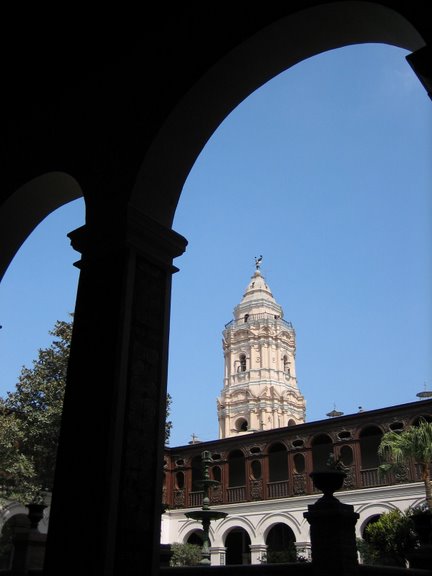 As in most of the convents in Lima, Santo Domingo is a sort of city inside the city. [From the main hall] we walked into a succession of cloisters surrounded by service areas and communal rooms and tried to imagine how magnificent this place originally looked when Martín came to live here. . . .Then we went to see the cell where Martin prayed daily in ecstasy . . . and would
As in most of the convents in Lima, Santo Domingo is a sort of city inside the city. [From the main hall] we walked into a succession of cloisters surrounded by service areas and communal rooms and tried to imagine how magnificent this place originally looked when Martín came to live here. . . .Then we went to see the cell where Martin prayed daily in ecstasy . . . and would
Convent of Santo Domingo
spend countless hours praying for the salvation of people.
But the best part of our visit was the main garden, beautifully kept and full of blossoming flowers, trees and birds; they are descendants of the ones that Martin himself used to feed every day of his life. . . . [T]he quietness takes you away from the city noises and activities and brings a sensation of calmness to the soul. It was great to walk down the paths Martín himself once walked feeding and healing thousands of poor and sick people. He always took everyone in, regardless of race or social status, and even when his superiors told him he was breaking the rules he simply replied, “Father, charity knows no rules.”
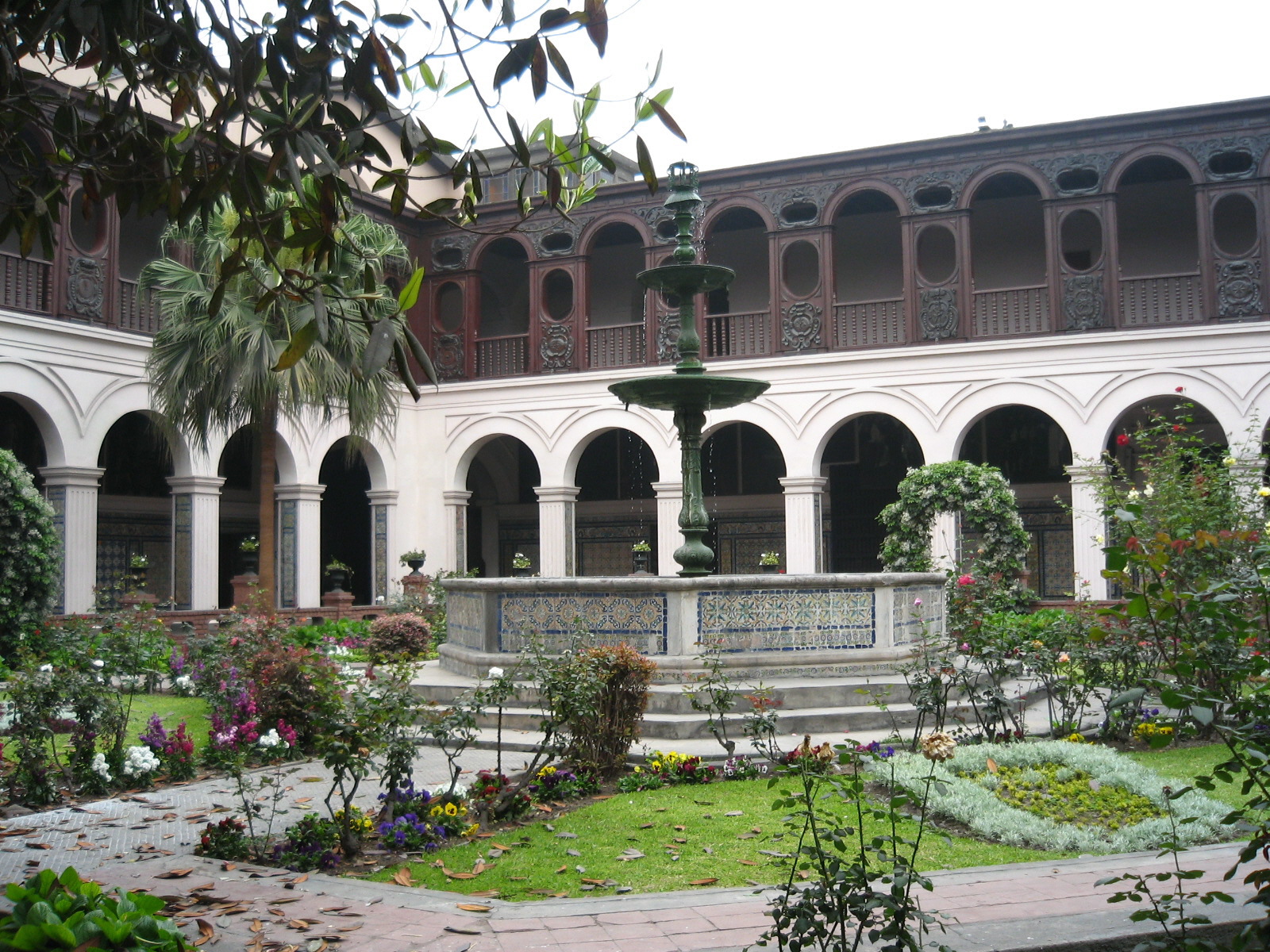 Many paintings in Santo Domingo reminded us that Martín loved all God’s creatures. He treated animals like brothers and sisters, talked to them and understood their pain and sufferings. He considered them children of God and cared for them with the same tenderness and reverence with which he treated humans. . . .There is the story of the injured cat he found in one of the poorest neighborhoods in Lima. The cat was bleeding profusely from the head and was almost dead when Martín picked him up to take care of the wound. After the initial treatment Martín asked him to come back to the convent every morning and so he did! The cat came every morning at 7:00 a.m. until his treatments were over and he was totally healed. . . . Once Martin healed a wounded deer that had been shot by a hunter and set him free. For years afterwards The deer kept coming down from the hills to be fed and petted by Martín. . .
Many paintings in Santo Domingo reminded us that Martín loved all God’s creatures. He treated animals like brothers and sisters, talked to them and understood their pain and sufferings. He considered them children of God and cared for them with the same tenderness and reverence with which he treated humans. . . .There is the story of the injured cat he found in one of the poorest neighborhoods in Lima. The cat was bleeding profusely from the head and was almost dead when Martín picked him up to take care of the wound. After the initial treatment Martín asked him to come back to the convent every morning and so he did! The cat came every morning at 7:00 a.m. until his treatments were over and he was totally healed. . . . Once Martin healed a wounded deer that had been shot by a hunter and set him free. For years afterwards The deer kept coming down from the hills to be fed and petted by Martín. . .
When he died in 1639, . . . word of his miracles had made him known as a saint to every resident of the region. After his death, the miracles and graces received when he was invoked multiplied in such profusion that his body was exhumed after 25 years and found intact, and exhaling a fine fragrance. He officially became a saint in 1962, but for us Peruvians, he was and forever will be Brother Martín, Martín, or simply “Martincito” . . .
My pilgrimage to the church of Santo Domingo was an . . . uplifting experience that not only brought back the sweet memories of my grandmother tending to sick animals in her garden, but also renewed my conviction in the fight for animal rights. As animal advocates we must follow Martin's example and remember that the animals will never fail to find in him a powerful friend . . .
Essay Review: An Elephant Love Story
"Family Ties: The Elephants of Samburu, An African Love Story." Essay by David Quammen. Photographs by Michael Nichols. National Geographic, September 2008.
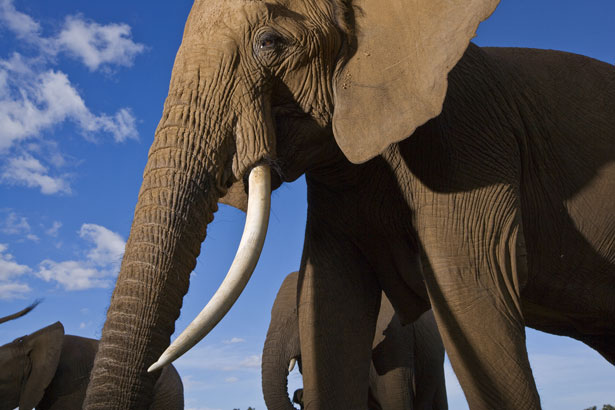 The "Love Story" of the subtitle refers both to the great love elephants have for each other, and the love Iain Douglas-Hamilton has for them. This great scientist obtained his Oxford doctorate with a project using radio telemetry to carry out the first serious study of elephant social structure and "spatial behavior" (their comings and goings, to put it in simpler language). Today he continues to use high tech: some twenty of the elephants he studies are supplied with global positioning systems and cell phones. Their daring treks across the rugged African landscape are carefully mapped. A version of the map appears on a wall of a Kenyan government office. "I noticed a single red line running northeast from Marsabit far into the desert, and I thought: There goes Mrs. Kamau." Unfortunately, this detailed map showing the progress of individuals is not included in this article.
The "Love Story" of the subtitle refers both to the great love elephants have for each other, and the love Iain Douglas-Hamilton has for them. This great scientist obtained his Oxford doctorate with a project using radio telemetry to carry out the first serious study of elephant social structure and "spatial behavior" (their comings and goings, to put it in simpler language). Today he continues to use high tech: some twenty of the elephants he studies are supplied with global positioning systems and cell phones. Their daring treks across the rugged African landscape are carefully mapped. A version of the map appears on a wall of a Kenyan government office. "I noticed a single red line running northeast from Marsabit far into the desert, and I thought: There goes Mrs. Kamau." Unfortunately, this detailed map showing the progress of individuals is not included in this article.
We do see a fairly detailed map showing the Samburu National Reserve and surrounding areas. The Samburu, bless them, cling stubbornly to their traditional way of life, refusing to swell the ranks of the discontented and oppressed proletariat of modern civilization. This is good for them - they remain a free and reasonably happy people - and is also good for the elephants. Samburu and Elephants live side by side, as they have for time out of memory. They do not live in perfect harmony, but at least they do not do too much harm to each other.
The elephants do not live in perfect harmony with each other either, but they do love and care for each other. This can be seen in the story of Babel and Babylon. Dr. Douglas-Hamilton has done for the pachyderms what Jane Goodall did for the chimpanzees: given them individual names, and treated them as individuals. The elephants are named in an ingenious and creative manner: the members of a given family are named following a common theme. For example, a family is named "The Biblical Towns" and its members receive names such as Babel, Babylon, Bethlehem, Jerusalem, Nazareth. Poor Babel was crippled when she was raped by a big inconsiderate male who was too big for her (the mothers try to protect their daughters and granddaughters from such mistreatment, but alas, they cannot always succeed) and her leg was broken. Grandmother Babylon, the head of the family, keeps the family moving at a slow pace so Babel is not left behind. This is not "instinct." It is moral, intelligent behavior. And I should point out that female leadership of the families does not mean that relations with males are usually bad. We see a male elephant visiting his female friends and relatives just to socialize and keep in touch, no sex involved.
 The article ends with the narrative of a frightening incident: a mother elephant named Diana, quite mistakenly thinking Iain was a threat to her and her children, attacked him and beat him up - but did not kill him and did not even cause any real injuries - only some bruises and scratches. "At the last moment she made a choice. She chose not to kill him" says the author. "And no one, not even Iain Douglas-Hamilton, with all his magical gadgetry and his hard-won knowledge, will ever know why." Personally, I do not think it is such a great mystery. A moral, intelligent, sane and non-carnivorous being, given any choice at all, will choose not to kill.
The article ends with the narrative of a frightening incident: a mother elephant named Diana, quite mistakenly thinking Iain was a threat to her and her children, attacked him and beat him up - but did not kill him and did not even cause any real injuries - only some bruises and scratches. "At the last moment she made a choice. She chose not to kill him" says the author. "And no one, not even Iain Douglas-Hamilton, with all his magical gadgetry and his hard-won knowledge, will ever know why." Personally, I do not think it is such a great mystery. A moral, intelligent, sane and non-carnivorous being, given any choice at all, will choose not to kill.
The essay has painful aspects, but in the insights and knowledge it provides, it helps in the long task of liberating us from the bonds of anthropocentrism. And--as love always will--it inspires.
—Benjamin Urrutia
Film Review: Space Chimps
SPACE CHIMPS: A 2008 animated film by Vanguard Animation and 20th Century Fox, written and directed by Kirk De Micco, starring Andy Samberg as Ham III and Cheryl Hines as Luna.
 The first American in outer space (in reality) was a chimpanzee named Ham. I remember seeing his photo in Life and in National Geographic. He was brought back to Earth alive and healthy, as were all monkeys and apes the USA sent into orbit and sub-orbit, in contrast to the USSR, which sent a poor dog named Laika into orbit, knowing they would not bring her back alive. Personally, I think that's one important reason that the Soviet Union has gone into the trash-dumpster of history . . . .
The first American in outer space (in reality) was a chimpanzee named Ham. I remember seeing his photo in Life and in National Geographic. He was brought back to Earth alive and healthy, as were all monkeys and apes the USA sent into orbit and sub-orbit, in contrast to the USSR, which sent a poor dog named Laika into orbit, knowing they would not bring her back alive. Personally, I think that's one important reason that the Soviet Union has gone into the trash-dumpster of history . . . .
According to Space Chimps, in the near future, an unstaffed probe is sucked to far space by a wormhole, and all contact is lost. The NASA scientists are in a dilemma: sending another unstaffed probe would not bring about any better results, but sending humans could result in their deaths. The logical compromise: revive the Space Chimp program. To secure public support and financing for this, a ruthless politician drafts Ham III, grandson of Ham, the aforementioned first US-American astronaut.
This PR stunt brings about many unintended consequences. Meanwhile, the unstaffed probe has fallen into the unworthy hands of the nastiest creature of a distant world, whose tyranny is causing suffering to the local sentients. The Space Chimps decide to change their mission objective from just getting back alive, to liberating their fellow sentient beings from cruel oppression. The chimps end up proving that they are braver and more resourceful than their human handlers. Most importantly of all - they are more compassionate. "There is no pre-eminence of a man above a beast," says the author of Ecclesiastes, but in this case it is the the beasts who show moral pre-eminence.
In the end, there is full reconciliation and friendship between Chimps and Humans, as well as between Earthlings and Aliens.
Besides having some excellent messages, Space Chimps is one of the funniest movies I've seen this year, a visual treat for the eyes, and a very exciting adventure - not a dull moment. It is very rare to encounter a film that is so entertaining and so uplifting at the same time.
--Benjamin Urrutia
Gems
“It should not be believed that all beings exist for the sake of the existence of man. . . .[T]here is no difference between the pain of humans and the pain of other living beings, since the love and tenderness of the mother for the young are not produced by reasoning, but by feeling, and this faculty exists not only in humans but in most living beings.”
~ Rabbi Moses ben Maimon (1135 – 1204), Jewish philosopher and theologian, codifier of the Talmud.
--Contributed by Lorena Mucke
"I prayed for twenty years, but received no answer until I prayed with my legs."--Frederick Douglass
"Do all you can and don't worry about the odds against you. Wield the miracle of life's energy, . . . concerned only that . . . we do so with all our might. That's all we need to know to feel certain that all our force of diligent effort is worth our while on Earth." -Carl Safina, Voyage of the Turtle
--Contributed by Lorena Mucke
Recipes
Seitan in Saffron Cream Sauce
Serves 2 -3
¼ cup dry white wine
1 tsp. saffron threads
2 T. Earth Balance buttery spread, at room temperature
1 cup unsweetened plain soy milk
1 T. cornstarch
2 T. extra virgin olive oil
2 cloves garlic, minced
¼ tsp. dried thyme
¼ tsp. ground rosemary
¼ tsp. dried marjoram
¼ tsp. onion granules
1 package West Soy “chicken” style Seitan, drained
sea salt, to taste
freshly ground black pepper, to taste
In small saucepan, warm the white wine and add saffron threads. Cover and let sit, to infuse the saffron, for at least 20 minutes. Add the Earth Balance – it may be necessary to turn on low heat to slowly melt the Earth Balance. Remove from heat once Earth Balance has melted. Set aside and keep covered.
In another small saucepan, whisk cornstarch into soy milk. Warm and stir constantly until soy milk begins to thicken. Then, stir in saffron and wine mixture. Stir well to mix. Cover and set aside.
In a medium-size skillet, warm olive oil; add garlic, herbs and Seitan over medium heat. Stir with wooden spoon until heated through. Adjust seasoning with sea salt and freshly ground black pepper. Remove from heat.
Spoon the saffron cream sauce over Seitan and jasmine rice. Serve with sautéed peas and red peppers for a lovely and delicious dish.
-- Angela Suarez
Cream of Butternut Squash Soup
serve 6
 1 yellow onion, finely chopped
1 yellow onion, finely chopped
2 T. extra virgin olive oil
1 medium-large butternut squash
8 cups vegetable broth
sea salt, to taste
freshly ground black pepper, to taste
¼ cup vegan Parmesan
¾ cup fine bread crumbs
In a large saucepan sauté onion in olive oil until translucent. Add butternut squash along with ½ cup spring water and cook until squash is tender. Place butternut squash and onion in the bowl of a food processor and process until puréed. This may need to be done in 2 or more batches, depending on size of food processor bowl. Return butternut squash purée to saucepan; add vegetable broth. All 8 cups may not be needed. Allow the soup to remain fairly thick. Season to taste with sea salt and freshly ground black pepper.
Cook on low heat until evenly heated and hot. While soup is finishing, mix vegan Parmesan and bread crumbs together in a glass jar. Ladle soup into individual bowls and sprinkle with this mixture. Serve immediately.
-- Angela Suarez
Pilgrimage-Essay: Benjamin Urrutia
Note: The original Pilgrimage narrative of our reviewer Benjamin Urrutia may be found in PT5. Here he offers us an update.
Over the last few years, one of my two main occupations and preoccupations (the other one, of course, being writing for you here at The Peaceable Table) has been to develop and propound my theory that Jesus was one of the main leaders--perhaps the main leader--of the magnificent action of nonviolent resistance by the Jewish people in the year 26 CE as 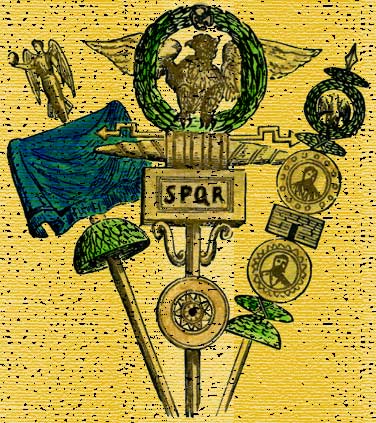 described in the writings of Flavius Josephus. The protesters were opposing the arrogant plan of the Roman procurator Pontius Pilatus to set up the Eagle standards sacred to Jupiter in Jerusalem. To the Jews, given their abhorrence of idolatrous images of any sort, but especially in the Temple, this act would have been the worst of abominations. The protesters' plan was brilliant: refusing to sow the next season's crops,
described in the writings of Flavius Josephus. The protesters were opposing the arrogant plan of the Roman procurator Pontius Pilatus to set up the Eagle standards sacred to Jupiter in Jerusalem. To the Jews, given their abhorrence of idolatrous images of any sort, but especially in the Temple, this act would have been the worst of abominations. The protesters' plan was brilliant: refusing to sow the next season's crops,
Roman Army Standards
they came en masse, unarmed, to Pilate's headquarters in Caesarea Maritima (note the imperial name of the city) on the Mediterranean coast, and carried out a prolonged lie-down strike around his palace.
The unscrupulous Pilate would not have hesitated to massacre this low-life as he did on other occasions, but he had to face the fact that this time there would be unpleasant consequences. Even the Romans were dependent on the nations' crops, of whose profit they habitually extorted a large share; an unsown crop would mean a serious loss. Even the bloodiest tyrant is dependent on his subjects' cooperation. So Pilate gave in and announced that he had scrapped his plan, and the peasants quietly went back to their fields--no doubt suppressing a quiet smile.
Given what we know of Jesus' creativity, devotion to the kingdom of God, and commitment to nonviolence and love of the enemy, it seems very likely that he would have been involved in this action-- world history's first successful major civil disobedience--which took place the very year his ministry apparently began. He was from a peasant village of Galilee, and brought up to think as a farmer thinks. He was deeply concerned with humanity's daily bread, both as physical reality and as symbol of the messianic banquet to which all, high and low, are invited. Bread comes from the sun and the rain which God sends on just and unjust alike; bread is the gift that overstuffed Roman and half-starved peasant alike need each day.
The picture of Jesus as participant or leader in this action goes together with the image, growing stronger in my mind, of Jesus as a great vegan teacher. Veganism is a very important part of animal rights, and nonviolent resistance is a very important part of pacifism. And pacifism and veganism go together like rice and beans, or inside and outside; they are inseparable. If one practices nonviolence regarding humans but not regarding animals (or vice versa), one can rightly be accused of inconsistency, even hypocrisy. Of course some people have been guilty of such inconsistency and worse, but that is no excuse for me and thee.
My own spiritual pilgrimage's commitment to keep my food kosher (which means, in my book, to keep it nonviolent) has evolved to the point that I carefully scrutinize the content labels of salads and pastries to make sure they contain no animal products, i.e., no eggs, no dairy. The result is that more and more I make my own salads and my own cookies. This means reducing my consumption of plastic and other packaging, eating more healthily, losing extra weight, and saving quite a bit of money.
Yes, one reaps rewards from asking "What would Jesus eat?" and following where conscience leads.
Pioneers: Emily Gardner, 1825 - 1906
The decade of the 1840s in the United States was a time, not unlike the 1960s, when spiritual seeking and visions of utopian social reform caught up a number of young people, leading them to "drop out," adopt radical new lifestyles (including vegetarianism), and form communes with the like-minded. Just as had the civil rights movement in the later era, the cause of abolition of human slavery had awakened many to awareness of vast social evils. But soon enough the enthusiasm of 1840s reformers carried them on to other idealistic causes as well: equality for women, temperance, education reform, natural diet, rejection of violence, the belief that law can only come from within. The most radical reformers were linked by a movement called the Society for Universal Inquiry and Reform, which flourished 1842-1846. Its adherents were mainly liberal Quakers and New Englanders of the Transcendentalist stamp.
In the 1840s, numerous communes were formed in attempts to put the new hopes into practice. Most were ephemeral, like those of the 1960s, wrecked on the shoals of financial and personality issues, including abuse of the freedom to work or not as one felt called. Yet the memory of these dream-cities remains as a tribute to the better world their citizens hoped to see.
Of all those whose fervent enthusiasm for Universal Reform lingers in letters and memoirs, one name stands out, above all for her concern for animals as well as human unfolding: Emily Gardner, a youthful Quaker schoolteacher from Indiana. She was involved in a series of utopian communal groups, and writes with insight and appealing passion of her commitment. In one letter, she awaited "the dawn (at least) of the morn of millennial glory," envisioning a world in which people would "return to paradise and liv[e] like our parents before the fall," when "not only all mankind but all animated creatures existing in God's Government and into which he had breathed the breath of life shall live in perfect harmony and peace." In other words, the beginning of the Peaceable Kingdom here on earth.
We have been unable to learn much about Emily Gardner's prior life except that she was born January 16, 1825 in a family of Orthodox Friends, and was early committed to the cause of abolishing human slavery. She became active in communes and Universal Reform together with an older sister and brother in the spring of 1844, when she was all of eighteen. In that year she joined the Prairie Home commune in Indiana. Of her first experiences there, Gardner wrote lyrically, "Most sweetly did it chime with my highest aspirations after a true life." She "rejoiced that there was one spot at least on this broad and beautiful earth as free as the air and sunlight which play around and beautify it," and she looked forward to a time when the entire west would be "dotted over with free homes and free minds."
Nearly all Prairie Home communards were followers of "diet reform" and strict vegetarians. Diet reform then meant essentially following the advice of Sylvester Graham, now best known as inventor of the graham cracker, but then a popular lecturer famous for claiming that irritation of the stomach by unhealthy foods was the cause of most disease. Graham advocated a diet of fruits, vegetable, and whole wheat bread, together with abstinence from meat, tea, coffee, alcohol, and rich sauces and spices. (He would have scorned the graham cracker we have today, a piece of sugary junk.)
Unfortunately, problems arose at Prairie Home. The community had a good complement of workers in various fields, and some 44 children in the school in which Emily was presumably a teacher; but it was was so free and formless as to have no constitution. Admission was wide-open. Like most Universal Reform people, its members believed only in guidance by the natural law within, a concept close to the Quaker Inner Light. If humans would only trust "the divine image within" instead of the "strong arm of the law," they and the world would be far happier, Emily wrote. Thus, although there were meetings at which decisions were made, no sanctions or mechanism for enforcement existed; and as one veteran said later, there were too many "who loved to talk more than they did to work."
The love for talking was partly because many of them had been marginalized by or even evicted from their home Meetings and churches due to their radical stance regarding human slavery and other reformist causes. After this painful rejection of their cherished ideals, it felt wonderful to have kindred spirits to share them with. But without firm arrangements for getting the work of the community done, and with the financial and other problems that arose, it is not surprising that Prairie Home fell apart before long.
But Emily and some other enthusiasts did not hesitate to move on to another similar venture, Union Home, and finally still another short-lived communal endeavor, Kristeen. Despite the early disappointments, her ardor, during the time for which we have her letters, did not flag. Of her companions in such an idealistic way of life, she said, "Tis pleasant indeed to be acquainted and hold converse with such minds," for how would one find pleasure only "with those whose ideas and conversations [are] confined to dress and fashion [and] good things to eat," ("good" clearly meaning conventionally tasty rather than healthy).
Taking Quaker pacifism to the outer limits, the Universal Reformers generally believed in nonresistance--total nonviolence-- even as they believed in no external law. This position, together with their general adherence to a grahamite vegetarian diet, tended toward an aversion to animal slaughter. Referring to the screams of slaughter, Emily wrote, "I'm tired of living among squealing hogs and squalling chickens and bawling cows and murdered calves and slaughtered lambs and barking dogs and where even the free birds of heaven hardly dare come near while chanting their sweet song. The idea of taking the life of innocent animals always appeared so horrible that I abandoned the use of their flesh before I knew there was such a person in existence as Sylvester Graham." She must have been very young indeed to be thinking such revolutionary thoughts, and acting on them.
Little is known of her later life beyond a bare outline. She was married in a nonreligious ceremony to fellow abolitionist Isaac R. Phenis in 1852, and during the 1850s they had two daughters, Lucy and Florence, and two sons, Albert and Vinton. Isaac was an attorney who later served in the cavalry in the Union army, which suggests that Emily came to some kind of compromise with the use of force. In 1868 they moved to Greenwood Country, Kansas, where he became a probate judge. Emily died in August, 1906, praised (by a male speaker) as having been "endowed with superb intelligence [and] beautiful sublimity of character . . ."
Emily Gardner's is an attractive youthful voice. Her early challenging of convention, her sensitivity, idealism, and seemingly boundless enthusiasm for trying new ways of life that cherish all beings remind us that such persons have illumined the world in many ages, even if little known of them outwardly. As we try to recover and live by what is viable in the same dreams, let us keep in mind her bright spirit.
--Robert and Gracia Fay Ellwood
Based on Thomas D. Hamm, God's Government Begun: The Society for Universal Inquiry and Reform, 1842-1846; personal communication from Thomas Hamm (Director of the Institute for Quaker Studies at Earlham College); and online sources.
The Peaceable Table is
a project of the Animal Kinship Committee of Orange Grove Friends Meeting, Pasadena, California. It is intended to resume the witness of that excellent vehicle of the Friends
Vegetarian Society of North America, The Friendly
Vegetarian, which appeared quarterly between 1982 and
1995. Following its example, and sometimes borrowing from its
treasures, we publish articles for toe-in-the-water
vegetarians as well as long-term ones, news notes, poetry, letters, book
and film reviews, and recipes.
The journal is intended to be
interactive; contributions, including illustrations, are
invited for the next issue. Deadline for the November issue
will be Oct. 29, 2008. Send to graciafay@gmail.com
or 10 Krotona Hill, Ojai, CA 93023. We operate primarily
online in order to conserve trees and labor, but hard copy
is available for interested persons who are not online.
The latter are asked, if their funds permit, to donate $12 (USD) per year. Other
donations to offset the cost of the domain name and server are welcome.
Website: www.vegetarianfriends.net
Editor: Gracia Fay Ellwood
Book and Film Reviewers: Benjamin Urrutia & Robert Ellwood
Recipe Editor: Angela Suarez
NewsNotes Editors: Lorena Mucke and Marian Hussenbux
Technical Architect: Richard Scott Lancelot Ellwood

 In his book Whole in One, British philosopher David Lorimer relates the empathic life review to better-known psychic phenomena such as telepathy, and to many mystics' sense of participation in the life of all things. Lorimer sees such phenomena as evidence of a universal "empathic resonance," the basis of an "ethic of interconnectedness." In other words, if conscience tells us that callous or sadistic treatment of others is wrong, the reason is our intuition that at a deep level we participate in the pain we cause to other living beings--though in ordinary incarnate life we may not feel that pain. If "Love your neighbor as yourself" and "Love your enemy" are good advice, it is because we participate in the blessings and benefits we confer on our enemies and our neighbors, including our animal neighbors and the planet as a whole. There is no wall restricting moral principles to one's own group, or even to human beings. Eventually, we may expect to know it in a very concrete way.
In his book Whole in One, British philosopher David Lorimer relates the empathic life review to better-known psychic phenomena such as telepathy, and to many mystics' sense of participation in the life of all things. Lorimer sees such phenomena as evidence of a universal "empathic resonance," the basis of an "ethic of interconnectedness." In other words, if conscience tells us that callous or sadistic treatment of others is wrong, the reason is our intuition that at a deep level we participate in the pain we cause to other living beings--though in ordinary incarnate life we may not feel that pain. If "Love your neighbor as yourself" and "Love your enemy" are good advice, it is because we participate in the blessings and benefits we confer on our enemies and our neighbors, including our animal neighbors and the planet as a whole. There is no wall restricting moral principles to one's own group, or even to human beings. Eventually, we may expect to know it in a very concrete way. 
 Thank you so very much for sending me The Peaceable Table. I printed off all 18 pages since two of my favorite topics were mentioned: King Arthur and the Holy Grail, and St. Melangell.
Thank you so very much for sending me The Peaceable Table. I printed off all 18 pages since two of my favorite topics were mentioned: King Arthur and the Holy Grail, and St. Melangell.  As in most of the convents in Lima, Santo Domingo is a sort of city inside the city. [From the main hall] we walked into a succession of cloisters surrounded by service areas and communal rooms and tried to imagine how magnificent this place originally looked when Martín came to live here. . . .Then we went to see the cell where Martin prayed daily in ecstasy . . . and would
As in most of the convents in Lima, Santo Domingo is a sort of city inside the city. [From the main hall] we walked into a succession of cloisters surrounded by service areas and communal rooms and tried to imagine how magnificent this place originally looked when Martín came to live here. . . .Then we went to see the cell where Martin prayed daily in ecstasy . . . and would 
 The article ends with the narrative of a frightening incident: a mother elephant named Diana, quite mistakenly thinking Iain was a threat to her and her children, attacked him and beat him up - but did not kill him and did not even cause any real injuries - only some bruises and scratches. "At the last moment she made a choice. She chose not to kill him" says the author. "And no one, not even Iain Douglas-Hamilton, with all his magical gadgetry and his hard-won knowledge, will ever know why." Personally, I do not think it is such a great mystery. A moral, intelligent, sane and non-carnivorous being, given any choice at all, will choose not to kill.
The article ends with the narrative of a frightening incident: a mother elephant named Diana, quite mistakenly thinking Iain was a threat to her and her children, attacked him and beat him up - but did not kill him and did not even cause any real injuries - only some bruises and scratches. "At the last moment she made a choice. She chose not to kill him" says the author. "And no one, not even Iain Douglas-Hamilton, with all his magical gadgetry and his hard-won knowledge, will ever know why." Personally, I do not think it is such a great mystery. A moral, intelligent, sane and non-carnivorous being, given any choice at all, will choose not to kill. The first American in outer space (in reality) was a chimpanzee named Ham. I remember seeing his photo in Life and in National Geographic. He was brought back to Earth alive and healthy, as were all monkeys and apes the USA sent into orbit and sub-orbit, in contrast to the USSR, which sent a poor dog named Laika into orbit, knowing they would not bring her back alive. Personally, I think that's one important reason that the Soviet Union has gone into the trash-dumpster of history . . . .
The first American in outer space (in reality) was a chimpanzee named Ham. I remember seeing his photo in Life and in National Geographic. He was brought back to Earth alive and healthy, as were all monkeys and apes the USA sent into orbit and sub-orbit, in contrast to the USSR, which sent a poor dog named Laika into orbit, knowing they would not bring her back alive. Personally, I think that's one important reason that the Soviet Union has gone into the trash-dumpster of history . . . .  1 yellow onion, finely chopped
1 yellow onion, finely chopped described in the writings of Flavius Josephus. The protesters were opposing the arrogant plan of the Roman procurator Pontius Pilatus to set up the Eagle standards sacred to Jupiter in Jerusalem. To the Jews, given their abhorrence of idolatrous images of any sort, but especially in the Temple, this act would have been the worst of abominations. The protesters' plan was brilliant: refusing to sow the next season's crops,
described in the writings of Flavius Josephus. The protesters were opposing the arrogant plan of the Roman procurator Pontius Pilatus to set up the Eagle standards sacred to Jupiter in Jerusalem. To the Jews, given their abhorrence of idolatrous images of any sort, but especially in the Temple, this act would have been the worst of abominations. The protesters' plan was brilliant: refusing to sow the next season's crops, 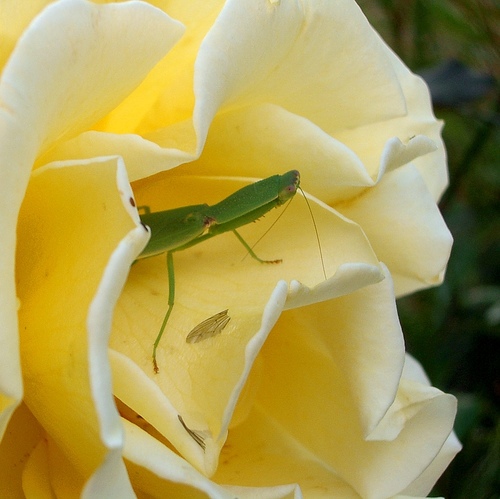 And other eyes not ours
And other eyes not ours